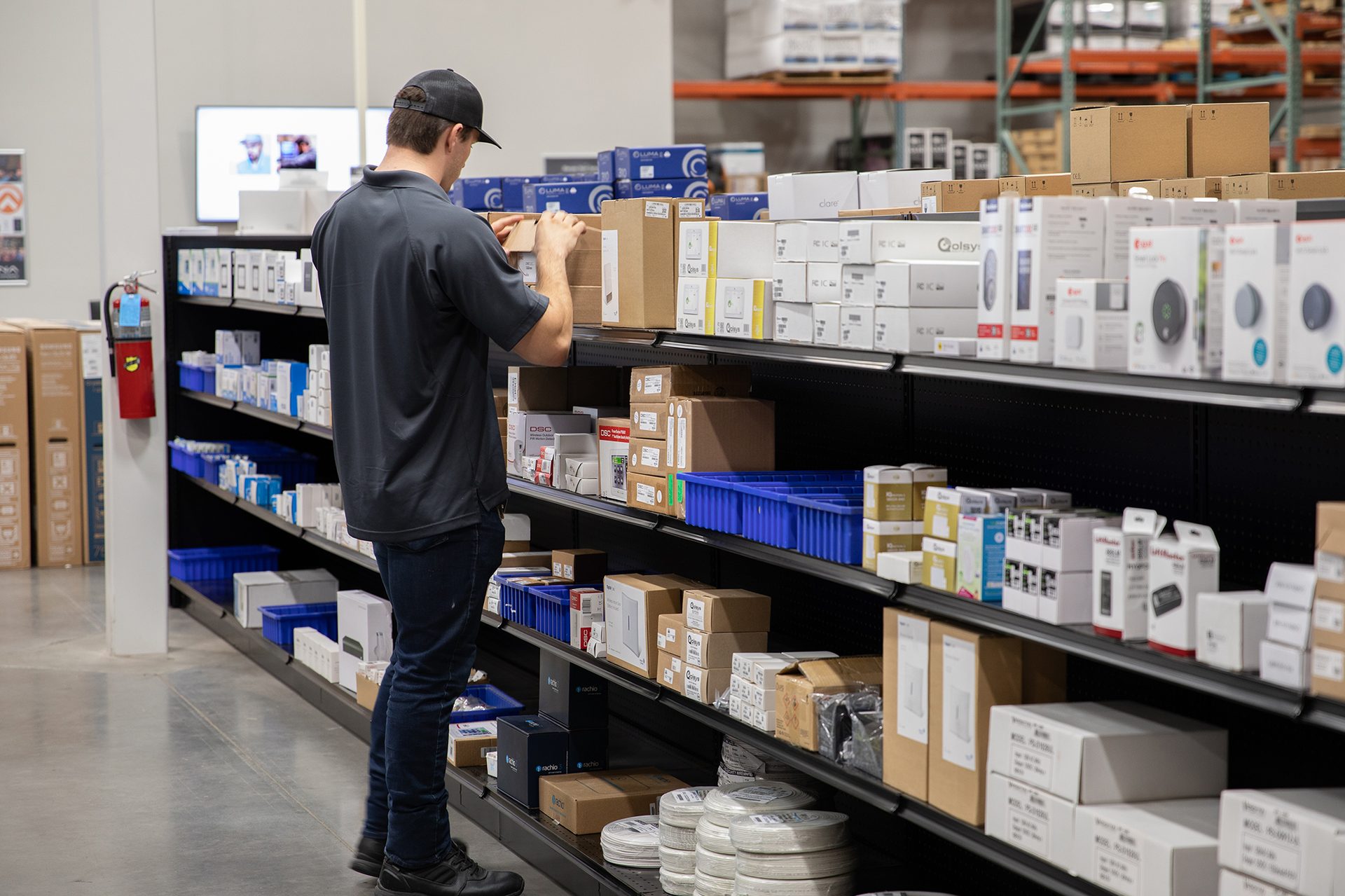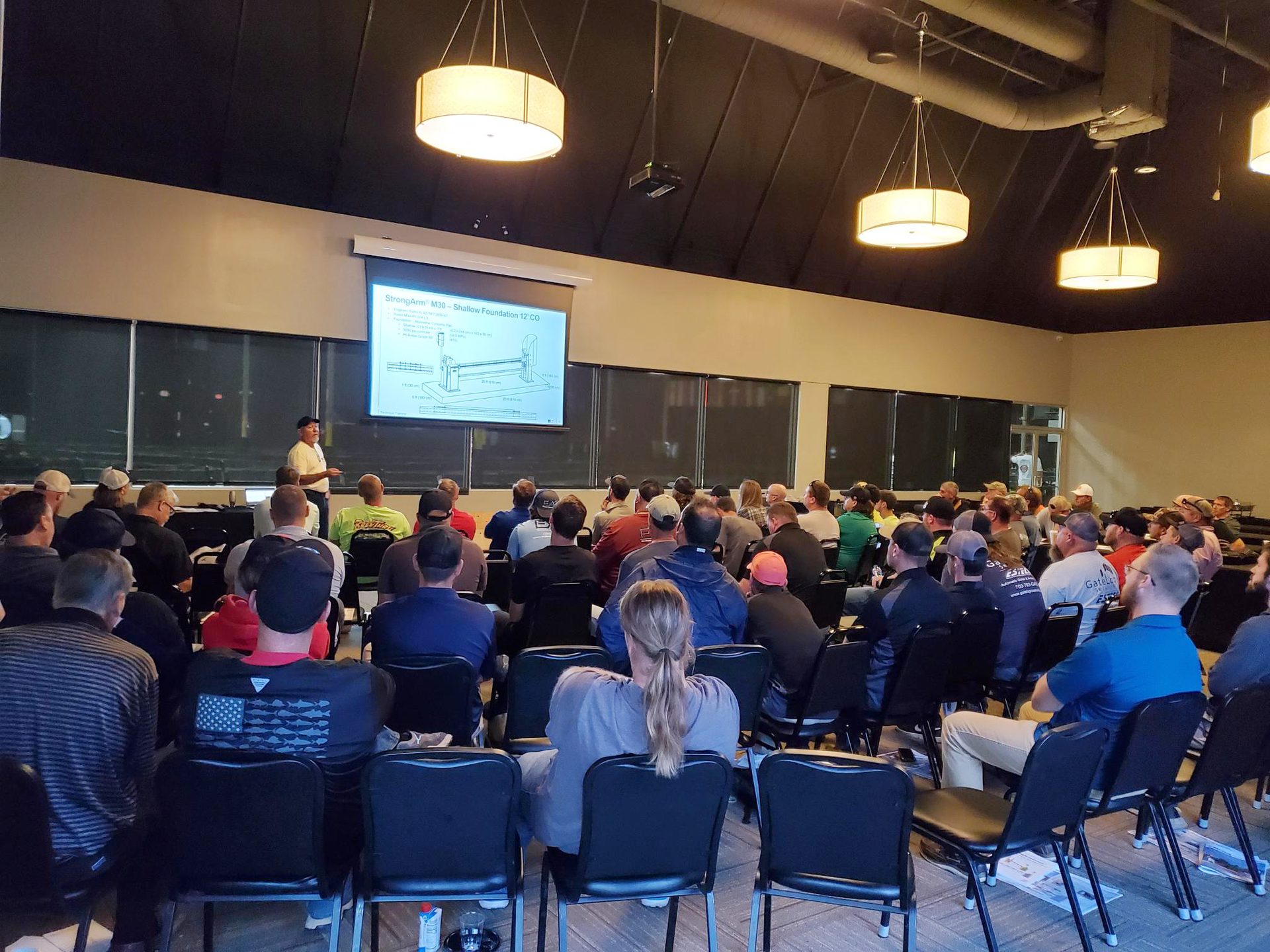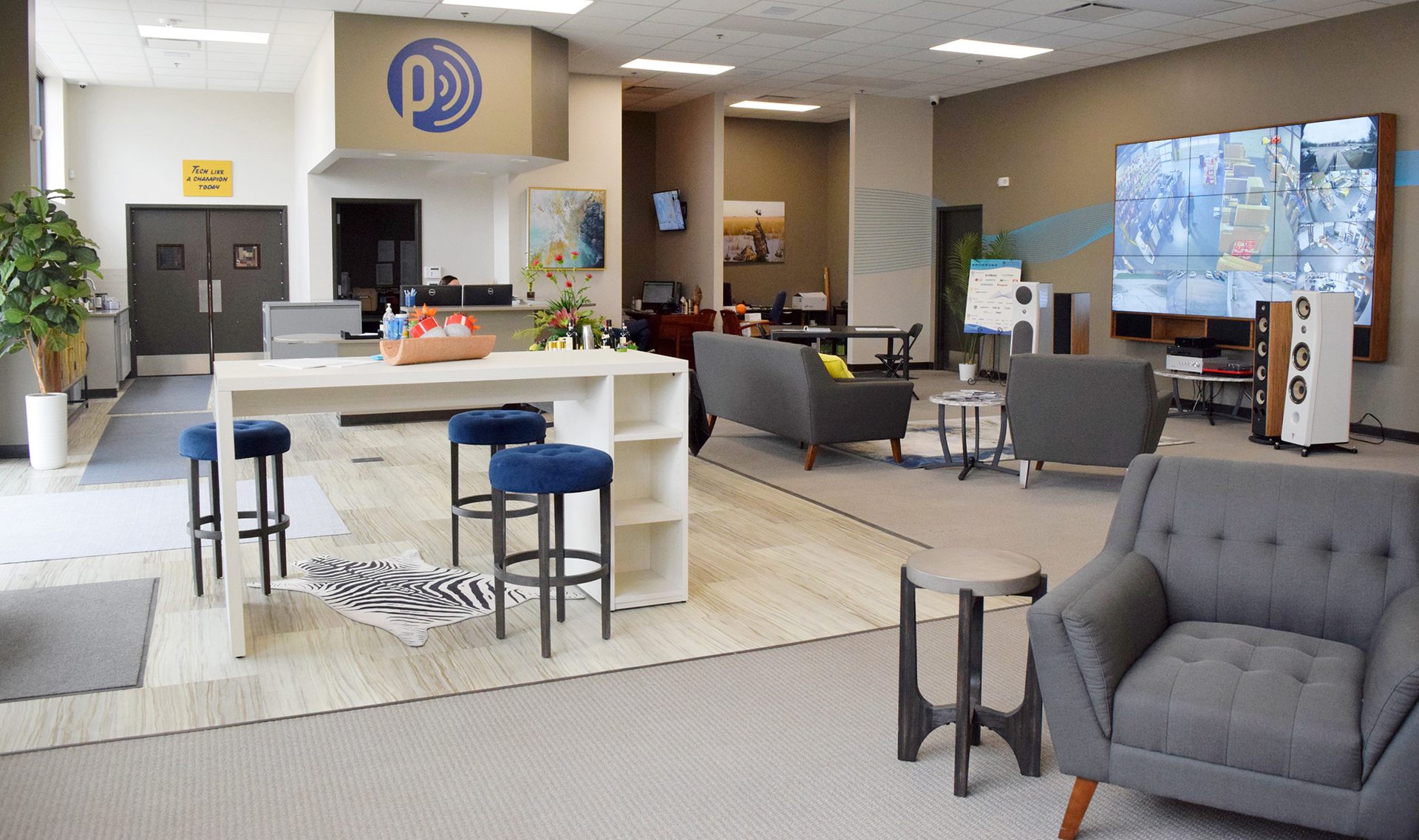// Distributor Training
Beyond COVID-19: Distributors Grapple With Supply Chain & More

Beyond COVID-19:
Distributors Grapple With Supply Chain & More
Keeping up to date on inventory levels is critical to navigating today’s supply chain landscape. Distributor Snap One combines clear partner communication and smart purchasing to help mitigate shortages. Here, a worker at Snap One partner Volutone checks inventory levels at its Scottsdale, Ariz., store.
image COURTESY OF SNAP ONE
While most distributors made a smooth transition to remote training during the pandemic, they are now facing another formidable roadblock that is plaguing everyone: supply chain shortages.
By Laura Mazzuca Toops, SDM Content Editor
Just as distributors adjusted to COVID-19 two years ago by enhancing remote training opportunities, today they are working through another challenge: a supply chain crisis.
The biggest pain point for dealers and integrators right now is “the state of the supply chain overall, including the costs of raw materials like metals and plastics,” says Eric Mardian, vice president, new business development, Southwest Automated Security (SAS), Dallas.
Because they’re on the front lines with customers, dealers and integrators must be able to deliver clear, candid information about component availability, cost and potential delays. For their part, distributors are using every tool at their disposal to keep their integrator partners up to date on this information — from beefing up inventories to updating dealers, integrators and end users through training programs and posting the latest supply information on websites and portals.
“We must be in constant communication with our partners,” says Brian James, vice president sales, networking and security at ScanSource, Greenville, S.C. “We are willing to take orders very early, stage products, and be creative with financing options to ensure we keep the flow of products moving for our partners.”
ScanSource also continues to invest in inventory and planning to ensure regular goods availability to partners. And to keep partners current, ScanSource updates product pricing daily and makes it available 24/7 through its online portal.
Dealers and integrators are struggling with capacity and inventory, says Clint Choate, senior director, security market at Snap One, Charlotte, N.C. Snap One uses a combination of clear partner communication and smart purchasing to help mitigate the supply chain malaise. “We are investing in supplier partnerships, people, processes and equipment to improve both capacity and inventory,” he says. “One pillar of our partner pledge is product selection and availability, with a focus on additional inventory and supply chain improvements. We know that when our dealers’ business succeeds, so does ours.”
Sandi Stambaugh, senior vice president, product management at TD Synnex, Fremont, Calif., says supply chain issues have evolved to include inventory overstock challenges, as dealers and integrators hold more products for longer periods of time. Correspondingly, lead times have been extended for certain components of the design — a trend that causes obvious cash flow challenges.
“The nice thing about distribution is, if there is a product you must have, hopefully we have it in stock,” says Dennis Holzer, executive director, PowerHouse Alliance, a Pittsburgh-based national consortium of regional wholesale distributors.
Top Training Topics
We asked our subject matter experts if there were any specific technologies or products that their partners were demanding training for, and whether it has changed over the past year or so. Here’s what they said:
- Continuing education: At Southwest Automated Security, CEU classes are always in demand, along with UL325-oriented products training, and sales training on specific products, says Eric Mardian.
- Full-solution training: More dealers and integrators are asking for full-solution training that is not specifically focused on a single product, but that also include application or vertical market-specific training, says Sandi Stambaugh, TD Synnex.
- Networking: “The biggest area now is still networking,” says Dennis Holzer of PowerHouse Alliance. “If you ask 10 integrators about the system in someone’s home, you’ll probably get five different answers.”
- Connected devices and technology: “Customers and distributors are looking beyond product specs, seeking deeper insights into application opportunities and underlying connectivity technologies,” says Lee U’Ren of Resideo. On the other end of the spectrum, students are also requesting more information on the basics, such as how Wi-Fi and Z-Wave work, how to deploy them quickly and consistently, and how they can adjust to those technologies in their businesses.
- Surveillance: During the pandemic, more homeowners upgraded their home security systems to include internal and external cameras, and devices like smart locks, says Dennis Holzer of PowerHouse Alliance. This increased demand for surveillance products has spurred the need for more product training.
- Embedded learning: More a technique than a topic, training that is embedded into the provisioning workflows of a product are more intuitive for learning, U’Ren says. For example, if a user is adding a new peripheral device to a security system, Resideo is exploring ways to offer an easy tutorial right at the time when questions arise in the field. “I believe that in-workflow learning that utilizes the micro-learning/on-demand format will be essential in product successes going forward,” he says. “On-boarding and new-hire training will be reduced if the information is always readily available in-task.”
//
He continues, “If not because of availability issues, we typically have a product a little below or above it in price, or a similar product from a different vendor. That’s the advantage of dealing with a distributor. Loyal dealers can come to us and say they have a project with 10 products, I will pick up the job from you when you have all 10 products. They don’t have to pay us, unlike a vendor; they will ship when they have the product. We’ll hold the product until the order is complete so there is no storage involved. It’s another luxury of doing business with distributors.”
The key to pushing through the supply chain crisis is clear communication among all parties, says Lee U’Ren, global director, products and services training enablement at Resideo, Austin, Texas. “Specifically in training, information can be a force multiplier. We believe that the more learning our customers consume, the more skills they will build to help reduce scrap due to mistakes, choose innovative products and technology that helps optimize the solution needed in a way that positively impacts the supply needs, or simply learn how to utilize many of our universal parts more effectively to replace the impact of hundreds of supply-chain-impacted SKUs.”
Switching Up Training Delivery
When the pandemic struck two years ago, distributors quickly adapted by introducing or expanding remote learning for their partners. Today, they are enhancing that training with up-to-the-minute information on inventory and other supply-chain issues on websites and portals.
“Our pricing is updated daily and available 24/7 through our online portal for our partners,” James says. An increased demand for training opportunities has affected how ScanSource trains its dealers, he adds. “Most of our partners prefer online training, as it saves on time and travel.”
Even before COVID-19, training was trending toward more virtual and hybrid educational events for dealers and integrators, and tech advances accelerated the trend, Stambaugh says. “While the COVID-19 pandemic certainly accelerated the evolution, we were already seeing a desire from dealers and integrators to work and learn from anywhere,” she says.
Although remote and hybrid training are still in use, much of the training offered by Southwest Automated Security entails hands-on learning skills in a classroom and in-the-field setting at its 19 nationwide branches.
image COURTESY OF SOUTHWEST AUTOMATED SECURITY (SAS)

While today TD Synnex offers remote, in-person and hybrid trainings, some methods work better for certain situations — such as hybrid or remote training for large groups, and live training for networking and more hands-on experience, she adds.
Many dealers and integrators prefer a combination of in-person, remote and hybrid training. “SAS offers all of the above,” Mardian says. SAS maintains state-of-the-art training facilities at each of its 19 nationwide branches, and its technical teams deliver training to customers. Options include CEU classes, lunch and learns and vendor counter days at the branches. SAS also conducts Security Expo events at select branches, providing customer training and networking with dozens of SAS vendor partners to learn about the latest products and services.
A big part of this information sharing involves updates on supply chain issues, Mardian says. “We provide a monthly price increase status report to our customers and are looking into posting this information on our website. Our branch teams also reach out to their local customers to inform them of upcoming price changes.”
Adapting to Supply Chain Issues
Subject matter experts interviewed for this story address inventory challenges, how they are contending with price increases and more.
“We have been able to leverage our robust network of distribution facilities to position inventory in support of rollouts and future forecasts. This has been especially helpful as we have seen volatility of pricing in the market. In addition to inventory support, our credit teams have provided extended terms and alternative financing options, where able, to support our dealers and integrators.” — Sandi Stambaugh, TD Synnex
“We’re making sure we buy stuff when it’s available, so our inventory is higher than it’s ever been. Supply chain issues are getting better, but it’s still hit or miss. Chipsets differ on every product; a combination may be available for one product, but not the other. Availability is a hair better, but there are still supply issues, and the cost of freight has skyrocketed. This has all led to significant cost increases. We’re all absorbing it a little bit, but at the end of the day, it’s now becoming so great that the consumer has to pay the price.” — Dennis Holzer, PowerHouse Alliance
“For the products we manufacture, we have controlled costs as much as possible and in some cases redesigned product around chip shortages to allow maximum flexibility for the future. We have invested in inventory with our suppliers and generally maintain very healthy levels of stock. Like most suppliers, we continue to see increased demand and our supply chain team works diligently to keep costs under control.
We are experiencing cost increases and have strategically absorbed some costs while adjusting prices where necessary. We guarantee our prices through a set date and if a price increase is to occur, we notify our partners well in advance of this date to give them ample time to adjust their plans and estimates. Our pricing is up to date and always live on our portals. Our portals are how our partners engage, learn and shop with us.” —Clint Choate, Snap One
“We saw this coming during the early stages of the COVID pandemic and placed stocking orders well in excess of our normal purchase volumes and out of sync with our standard purchase cycles. We continue to work with our vendor partners to manage the timing of price increase notifications to give us and our dealers and integrators as many items as possible to respond accordingly. Where possible, we’ve provided additional discounts and incentives to our dealers and integrators to help soften the impact of the ever-increasing prices. We continue to provide value-added services and are hiring more staff to support our customers and help them to achieve their goals.” — Eric Mardian, Southwest Automated Security (SAS)
//
Neither COVID-19 nor supply chain shortages have affected SAS’s growth over the past several years, he adds. “SAS has seen its biggest growth in the past several years and has added five new branches during this time,” Mardian says. “SAS continues to manage supply with ongoing orders to ensure stock of popular and much-needed items. We’ve absorbed as much of the cost increases as possible, trying not to pass too much on to our customers.”
Paramount to any training is “flexibility,” says Choate of Snap One. “As [supply chain] backlogs continue to grow, our partners do not want their staff out in the field to forget what they have learned when it’s time to actually install or service a product,” he says. “We focus on flexibility since integrators learn differently when it comes to when, where, and how they want training.”
Snap One offers remote, in-person and hybrid training, as well as pre-recorded training sessions through Snap One University — interactive, hands-on training tools that are well suited for in-home learning. Included in the mix are live training sessions in partner stores and offices with Snap One sales engineers, classroom events at its training centers, and via remote webinars.
Social media trends and the dramatic increase in video and micro-learning has heavily influenced current training techniques and enabled customers to quickly access the information they need. This translates to “bite-sized” learning in short videos and other formats, Choate says.
“In addition to traditional training methods, we continue to develop short training tech notes," he continues. “These bite-sized training videos are less than two minutes long and zip straight to the heart of the largest challenges or most popular features our partners seek information on.. In addition, we continuously monitor tech service calls to not only improve products from an engineering standpoint, but to use the data to refine training and create these tech skills. These efforts are making our partners more efficient and ensuring their installs are trouble free.”
Resideo continues to offer all forms of training services, including e-learning, webinars, private virtual training, blended learning and face-to-face training at its facility, ADI Global Distribution branches, as well as customer sites through its Resideo Academy learning platform, U’Ren says. Remote learning continues to be popular even as face-to-face attendance has resurfaced. Resideo data from May 2021 and May 2022 illustrates the trend, with a 106 percent increase in webinar attendance in 2022, and supporting 331 students in face-to-face sessions, compared with zero face-to-face students at COVID-19’s height in 2021. During the lockdowns, while Resideo adjusted to more virtual trainings, the distributor maintained high student counts and had more than 34,000 engagements in 2021.
“We anticipate even higher numbers in the next year as we transform our access capabilities and integrator learning into distributor learning systems,” U’Ren says.
Live training participants of Resideo Academy get hands-on skill support. Like everyone else, Resideo Academy’s instructors missed being in class with people during the pandemic.
image COURTESY OF RESIDEO

The distributor has also expanded into mobile apps for learning. “The need for that just-in-time information/learning has optimized Resideo’s mobile course development, mobile distribution tools and easy mobile search and navigation,” U’Ren says. “We also structure micro-learning into larger, more comprehensive programs that help students build credentials that help them in their careers. Training needs to include short-form and longer, more in-depth programs across multiple device formats so people can engage at the level they need.”
But in spite of the ongoing demand for remote learning, there is always room for old-school, face-to-face training — especially in the wake of pandemic quarantine. Although PowerHouse Alliance offers plenty of remote training options, including Zoom sessions and YouTube videos, in-person training is making a strong comeback. “We’re offering both, but we’re changing back to in person,” Holzer says. “We like to offer monthly training at each location. It was slower during COVID, so we went to Zoom. We’re not back 100 percent to in-person.”
During the pandemic, PowerHouse teamed up with CEDIA, the global association for smart technology, to provide each of its 60 national locations with its Certified Cabling & Infrastructure Technician (CIT) training, facilitated by a CEDIA-certified trainer at each location. CEDIA training is not product related, but focuses instead on technique, such as what wire to use where, proper networking systems and related topics, Holzer says. “We’re doubling down on training, and on the quality of trainers, who are now certified.”
Grappling With the Great Resignation
Besides the ubiquitous supply chain challenges, distributor partners are also grappling with issues arising from the Great Resignation: employee recruitment and retention. This is another area where well-designed training can help.
“Our partners continue to face challenges on capacity and with finding enough employees to help,” Choate says. “While we continue to refine our training methods and make ourselves available to our partners when and where they want to be trained, we also continue to refine software and hardware to make our products easier to deploy, install and use, which will relieve pressure on capacity.”
Partners in the PowerHouse Alliance national consortium of regional wholesale distributors provide onsite local training at over 60 locations, such as this Pioneer showroom.
image COURTESY OF POWERHOUSE ALLIANCE

Snap One is seeing more technicians use on-site learning as they install or service a product, and making products intuitive and training bite-sized ensures they stay ahead of the trend. “Through exceptional customer service and a variety of flexible training options, we strive to support our partners and their employees to make their lives easier,” Choate says. “We believe in investing in employees to meet the needs of our partners and reduce attrition.”
ScanSource focuses on training both current employees and new hires to bring everyone up to speed, James says. “We have always done both. We want to ensure all our employees are fully trained on the solutions and services we offer.”
At SAS, new hires can immediately access a multitude of training opportunities, Mardian says. “We have weekly national product training webinars delivered by our vendor partners to our branch and field teams,” he says. “All employees, new and current, participate in a company-wide interpersonal skills and leadership training program. We also provide employees industry and technology training delivered by our own tech support specialists.”
And U’Ren of Resideo finds that customer leadership teams are increasingly focused on skill development linked to measurable ROI. “Providing the information needed for people to do more when labor is tight is important,” he says. “I haven’t seen a shift of more existing employee or new-hire training, but more of a demand for training lead times to be shorter. Training needs to improve a business outcome and it needs to do so consistently with measurable ROI. Staffing shortages mean that time is even more expensive than ever before. Investments in training need to ensure that there will be a positive business outcome, regardless of whether it is for new or existing employees.” SDM

